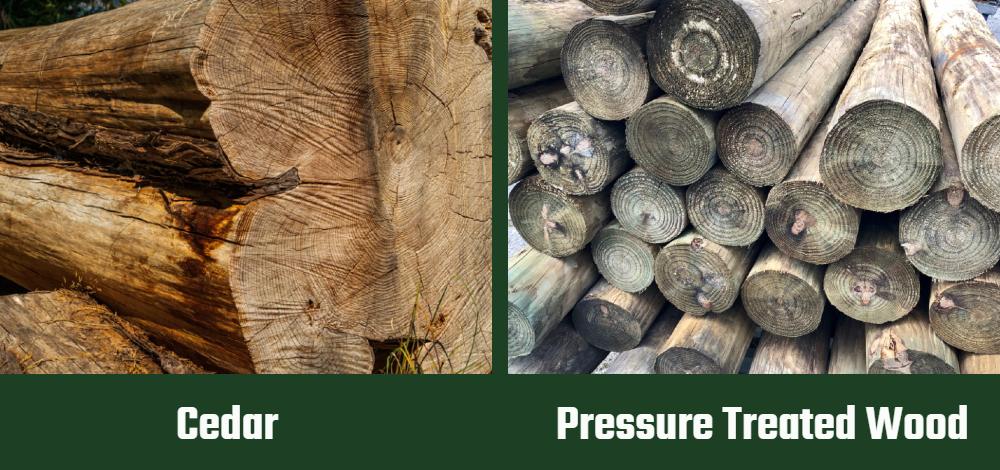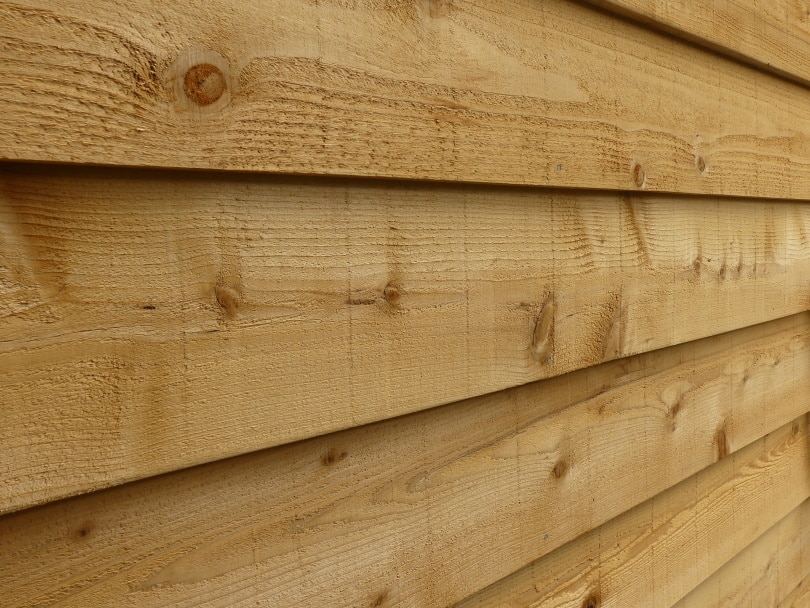Cedar vs. Pressure Treated Wood: What’s Best for My Project?
-
Kristin Hitchcock
- Last updated:

Both cedar and pressure-treated wood are used for a variety of different projects. However, they are both suitable for different situations—you cannot use them interchangeably most of the time.
Still, one is not necessarily better than the other. It depends on what your project is, as well as your climate.
In this article, we’ll compare each of these types of wood and help you determine which one is best for your project. As we said, there are suitable uses for both of these types of wood.
Overview of Cedar
What is Cedar?
Cedar is a type of tree that produces a unique type of wood. It is technically classified as a softwood. However, it is extremely resistant to the weather and quite durable—it isn’t actually that soft in practice. It is often used for household furniture and decks, though it also has other uses.
These trees create cones and have needle-like leaves. They are not deciduous, so they keep their pine needles year-round.
This wood is also known for its aroma. It is often used as incense for this reason. It is also naturally insect-repellant, likely because the oils that produce the scent are also quite rot-resistant, so it is a good option for many outdoor and indoor projects.

Benefits of Cedar Wood
There are many benefits of cedar wood, so it is well-loved by many DIYers. Firstly, it can resist decay and rot thanks to its special chemical properties. It repeals the microorganisms that are the cause of decay. There are several different types of cedar, though, and each of them has different benefits. However, they are all rot-resistant.
For instance, some of them are also insect-resistant. These can be utilized outside with bugs thanks to these properties. Still, it is often treated to prolong its life and for cosmetic purposes.
Cedar is often warp-resistant as well, which allows it to stand up to atmospheric moisture. It doesn’t crack nearly as easily as other woods. Because it is low-density, it is much more flexible than other types of wood out there.
In many cases, cedar is also weather-resistant thanks to the oils in the wood. However, direct sunlight can reduce this ability over time, so it is often important to treat it—just in case. Eventually, wood becomes vulnerable to cracking and discoloration if it is used outside.
However, for the most part, this wood is known for needing very little maintenance. For this reason, it can easily be used indoors and outdoors without much care over time.
- Rot-resistant
- Warp-resistant
- Low-maintenance
- Discolors
- Expensive
Overview of Pressure-Treated Wood
What is Pressure-Treated Wood?
Pressure-treated wood is pine that has been treated with chemicals in a holding tank. These chemicals help prevent rot and decay, allowing the wood to last longer. Usually, it is resistant to insects as well.
Usually, wood that is not normally resistant to the weather is best suited for this treatment. For this reason, pinewood is often utilized.
However, even this wood does not last forever. Wood is only as strong as the chemical preservatives used in them. Therefore, there are actually several different types of pressure-treated wood depending on the type of wood utilized.

Benefits of Pressure-Treated Wood
The main purpose of pressure-treated wood is to resist decay and be cost-effective in the face of outdoor elements. It is extremely cheap when compared to other outdoor wood options.
For instance, pressure-treated wood is much less expensive than cedar and has similar decay-resistant properties.
In many cases, pressure-treated wood is used outdoors. However, it can be used indoors as well. It is a cheap option for many projects, though it is not as cheap as some other types of wood.
- Insect-resistant
- Rot-resistant
- Not very expensive
- Contains hazardous chemicals
- High-maintenance
Decay Resistance Comparison
Both cedarwood and pressure wood are decay-resistant. The main purpose of cedar is that it is naturally resistant to decay. You can put it outside without any treatment. It resists all of the fungi and microorganisms that are responsible for decay.
Cedarwood is full of natural chemicals that work very similarly to the unnatural chemicals used in pressure-treated wood. However, because these oils are natural, they are often considered less harmful than the chemicals used in pressure-treated wood.
Because cedar has a natural resistance, it does not require maintenance. However, pressure-treated wood does require a bit of maintenance. It is prone to cracking and splitting, so it is more likely to be affected by moisture damage. It needs to be sealed regularly, as well.
Lifespan Differences
Technically, both of these types of wood can be used for decades. However, if you do not properly take care of pressure-treated wood, it will last much less time. Therefore, without any maintenance, cedar lasts longer.
Furthermore, in treated wood, the number of chemicals used in the wood matters. Not all pressure-treated wood is made the same. There are some significant differences between each type of wood and some will last longer than others.
For the most part, cedarwood will last for a minimum of 20 years, assuming that you clean it annually. However, it does require a lot less maintenance than other types of wood, so helping it last longer is much easier.
When using cedar on a deck, it will last about twice as long as a pressure-treated deck.
Installation
Typically, cedarwood is pretty easy to utilize. In many cases, you can use it just like you would use any other sort of wood. There is no reason to do anything special with the cedarwood.
However, installing pressure-treated wood is a bit different. You have to wear protective gear, including gloves, eye protection, and a face mask. It can cost more to install for this reason. Plus, not everyone will install pressure-treated wood for all projects. If you’re doing a DIY project, installing pressure-treated wood is more complicated.
Because the outside of the pressure-treated wood is the only part that is treated, you have to treat the ends after it has been cut, so it can be quite more complicated than other options out there.
Maintenance Differences
Cedarwood is much easier to maintain than pressure-treated wood. It only needs cleaning about once a year to stay in great condition. Often, it will change color with age, but you can add protective topcoats to cedar to make it last even longer.
Pressure-treated decks require a significant amount of maintenance. It provides annual cleaning and regular staining. You’ll need to seal it regularly to prevent rot. Furthermore, you’ll have to re-seal and re-stain multiple times over the years.
Environmental Friendliness
Cedar is a completely naturally occurring wood. Therefore, it is very eco-friendly. It will not harm the environment and decays eventually when you are done with it.
On the other hand, pressure-treated wood contains chemicals. These may harm the environment in some situations. For instance, burning these woods is not recommended in the least. The fumes can harm your lungs and the environment.
When you are done with pressure-treated wood, you have to take it to a site that is specifically designed to handle these types of wood. However, with cedarwood, you can simply burn it or dispose of it like you would anything else.
Conclusion
Cedarwood is quite expensive. However, it is naturally resistant to insects and decay and is often used in outdoor projects. It requires little maintenance, and you can seal it to help it last even longer. However, even without extra care, it will last for decades.
Pressure-treated wood is used more commonly than cedarwood because it is less expensive. It is treated with chemicals that prevent decay and it is a good option for those that need something cheap to use outside.
However, it is also more work and won’t last as long.
Featured Image Credit: (L) Jon-Spalding, Shutterstock | (R) jadimages, Shutterstock
Contents
